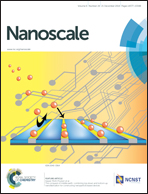Quantum state engineering with ultra-short-period (AlN)m/(GaN)n superlattices for narrowband deep-ultraviolet detection
Abstract
Ultra-short-period (AlN)m/(GaN)n superlattices with tunable well and barrier atomic layer numbers were grown by metal–organic vapour phase epitaxy, and employed to demonstrate narrowband deep ultraviolet photodetection. High-resolution transmission electron microscopy and X-ray reciprocal space mapping confirm that superlattices containing well-defined, coherently strained GaN and AlN layers as thin as two atomic layers (∼0.5 nm) were grown. Theoretical and experimental results demonstrate that an optical absorption band as narrow as 9 nm (210 meV) at deep-ultraviolet wavelengths can be produced, and is attributable to interband transitions between quantum states along the [0001] direction in ultrathin GaN atomic layers isolated by AlN barriers. The absorption wavelength can be precisely engineered by adjusting the thickness of the GaN atomic layers because of the quantum confinement effect. These results represent a major advance towards the realization of wavelength selectable and narrowband photodetectors in the deep-ultraviolet region without any additional optical filters.


 Please wait while we load your content...
Please wait while we load your content...